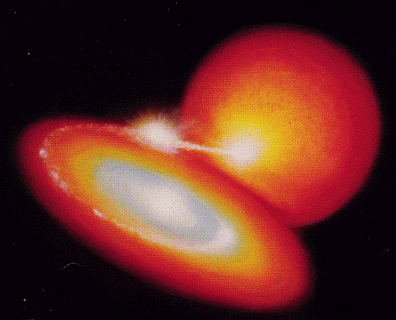
Image Credit, Dana Berry, STScI
The compact binaries program encompasses a number of scientific cartons, each with its own target selection strategy, organized around the common goal of multi-epoch spectroscopic characterization of known or suspected compact binary systems. Both the BOSS and APOGEE spectrographs are used by this program, depending on the system brightness. Generally, the target selection relies on the expectation that compact binary systems will show an excess in ultraviolet flux contributed by the (optically) unseen compact companion or shows distinctive variability. White dwarf binaries can be selected by a simple linear cut in a UV-optical color magnitude diagram, which is used for both the “gaiagalex” and volume limited “300pc” cartons. Candidate cataclysmic variables were identified from the AAVSO Variable Star Index. Various flavors of “UV-excess” color/magnitude cuts with different UV passbands result in the uvex1 – uvex5 cartons. The uvex1 – uvex4 cartons use the BOSS spectrograph, while uvex5 uses APOGEE.
Compact Binary Cartons in Targeting Generation 0.5.3
The “AAVSO catalog” (mos_cataclysmic_variables) was constructed from the VSX catalog, selecting cataclysmic (explosive and novalike) variables (N, NA, NB, NC, NL, NR, SN, SNI, SNII, UG, UGSS, UGSU, UGZ, ZAND) downloaded in summer 2019 and then manually pruned. The mos_catalclysmic_variables catalog can be queried on CasJobs or downloaded from the SAS.
The following selection functions define the individual cartons. Bulleted lists under each carton are “AND” conditions. In the below selection functions, the following definitions apply:
- FUV: Galex FUV magnitude
- NUV: Galex NUV magnitude
- rest: Bailer-Jones distances (pc)
- H: 2MASS H-band magnitude
- p: Gaia DR2 parallax (mas)
- perr: Gaia DR2 parallax error (mas)
- G: Gaia DR2 mean photometric G magnitude
- mwm_cb_300pc_apogee
- (FUV – 5 * log10(rest/10)) > 14 * (FUV-NUV) – 46
- rest <300
- H < 11
- mwm_cb_300pc_boss
- (FUV – 5 * log10(rest/10)) > 14 * (FUV-NUV) – 46
- rest <300
- Detected in Gaia DR2
- mwm_cb_cvcandidates_apogee
- AAVSO cataclysmic variable target
- H < 11
- mwm_cb_cvcandidates_boss
- AAVSO cataclysmic variable target
- Detected in Gaia DR2
- mwm_cb_gaiagalex_apogee
- p / perr > 3
- G < 20
- FUV + 5 * log10(p / 1000) + 5 > 1.5 + 1.28 * (FUV – G)
- H < 11
- mwm_cb_gaiagalex_boss
- p / perr > 3
- G < 20
- FUV + 5 * log10(p / 1000) + 5 > 1.5 + 1.28 * (FUV – G)
Details of the UV Excess Cartons
The UV Excess cartons use a common set of astrometric cuts on the closest Gaia cross-match to various UV catalogs, removing objects with small parallaxes and proper motions. Definitions used with the astrometric cuts are:
- pm: the total proper motion (mas/yr)
- pmerr: the total error in proper motion (mas/yr)
- rlo: the lower limit distance (pc) from Bailer-Jones DR2 distance catalog
- logpmdpm = log10(pm/pmerr)
- g_vis_per: Gaia DR2 visibility periods used
The selection criteria are
- rlo ≤ 1500
- g_vis_per > 5
- Neither of the two following conditions are met:
- (logpmdpm < 0.301) AND (p/perr > -1.4996 * logpmdpm – 4.05) AND (p/perr < 1.4995 * logpmdpm + 4.05)
- (logpmdpm – 0.301)2/0.397942 + (p/perr)2/4.52 ≤ 1
Additional color cuts are applied to select objects with UV excess between the main sequence and white dwarf sequence. For the uvex1, uvex2 and uvex5 cartons, Gaia is cross-matched with GALEX sources within 5”. The following additional definitions apply.
- NUVerr: Galex NUV magnitude error
- FUVerr: Galex FUV magnitude error
- G_AB: Gaia DR2 mean photometric G magnitude, in AB magnitudes
- G_AB = G – 25.688 + 25.792
- GBP_AB: Gaia DR2 mean photometric BP magnitude, in AB magnitudes
- GBP_AB = GBP – 25.351 + 25.386
- GRP_AB: Gaia DR2 mean photometric RP magnitude, in AB magnitudes
- GRP_AB = GRP – 24.762 + 25.116
- MG: absolute Gaia DR2 mean photometric G magnitude
- GBP: Gaia DR2 mean photometric BP magnitude
- GRP: Gaia DR2 mean photometric RP magnitude
- fuvg = FUV – G_AB
- GMS: Expected MGG for the main sequence defined by the following polynomial
- x = G – GRP
- GMS = 0.00206868742x6 + 0.0401594518x5– 0.842512410x4 + 4.89384979x3 – 12.3826637x2 + 17.0197205x – 3.19987835
- mwm_cb_uvex1
- NUVerr < 0.2
- NUV > -100
- FUVerr < 0.2
- FUV > -100
- MG > 4.09 OR MGG > 4.5457 * (GBP – GRP) + 4.0457
- MG > -1.11749253e-03 * (FUV-NUV)3 + 1.53748615e-02 * (FUV-NUV)2 + 3.66419895e-01 * (FUV-NUV) + 2.20026639)
- fuvg < 6.08 OR ((fuvg < 11.82 * (GBP_AB – GRP_AB) + 2.58) AND (fuvg < -0.79 * (GBP_AB – GRP_AB) + 9.21))
- mwm_cb_uvex2
- NUVerr < 0.2
- NUV > -100
- (MGG > 4.09 OR MGG > 4.5457 * (GBP – GRP) + 4.0457)
- (NUV – G_AB < 2.25) OR ( (NUV – G_AB < 6.725 * (GBP_AB – GRP_AB) – 1.735) AND (NUV – G_AB < -0.983 * (GBP_AB – GRP_AB + 8.24))
- mwm_cb_uvex5
- H < 15
- NUVerr < 0.2
- NUV > -100
- FUVerr < 0.2
- FUV > -100
- MGG > 4.0866
- |GMS-MG| ≤ 0.5
- rest < 0.51 * 10 0.2291G
The uvex3 carton cross-matches Gaia DR2 to the XMM-Newton Optical Monitor SUSS Catalog, v4.1 with a 3” search radius and uses the following quantities for color and quality cuts:
- UVM2_AB: AB magnitude in the XMM UVM2 band
- qflag: quality flags for the UVM2 band
- UVM2signif: significance of the detection in the UVM2 band
- mwm_cb_uvex3
- The following quality conditions are all NOT met
- qflag bit 1, 7, 8, or 9 is set
- qflag bit 2, or 3 is set AND UVM2signif < 10
- MG > 4.09 OR MGG > 4.5457 * (GBP – GRP) + 4.0457
- UVM2_AB – G_AB < 2.25 OR [(UVM2_AB – G_AB < 6) AND (UVM2_AB – G_AB < 5.57377 * (GBP_AB – GRP_AB) + 0.2049)]
- The following quality conditions are all NOT met
The uvex4 carton cross-matches Gaia DR2 to the Swift UVOT catalog with a 3” search radius, and uses the following quantities for color and quality cuts:
- UVW1_AB: Swift UVOT UVW1 bandpass in AB magnitudes
- UVW2_AB: Swift UVOT UVW2 bandpass in AB magnitudes
- qflag2: quality flags for the UVW2 band
- UVW2signif: significance of the detection in the UVW2 band
- mwm_cb_uvex4
- UVW1_AB > -100
- UVW2_AB > -100
- The following quality conditions are all NOT met
- qflag2 bit 0 or 6 is set
- qflag2 bit 1, 2, or 5 is set AND UVW2signif < 10
- MG > 4.09 OR MG > 4.5457 * (GBP – GRP) + 4.0457
- UVW2_AB – G_AB < 2.25 OR [(UVW2_AB – G_AB < 6) AND (UVW2_AB – G_AB < 5.57377 * (GBP_AB – GRP_AB) + 0.2049)]
Manual Cartons
The targets in these cartons were assembled from various catalogs of binary systems known to or suspected of harboring a neutron star or black hole, including the ATNF pulsar catalog, Mauro Orlandini’s catalog of accreting X-ray binary pulsars, the Ritter and Kolb catalog of low-mass X-ray binaries, the Blackcat catalog of black hole binaries and the Watchdog catalog of black hole binaries.
- manual_nsbh_apogee
- Selected on H-band brightness
- manual_nsbh_boss
- Selected on G-band brightness
Cadences
Targets in this carton can have a variety of cadences depending on the target brightness and whether multiple epochs of observation are needed to probe for radial velocity variations or optical spectral changes. The exception is the mwm_cb_uvex5 carton, which exclusively uses the multi-epoch bright_3x1 cadence. Otherwise, the following rules apply.
The single epoch bright_1x1 cadence is used for all cartons that use the APOGEE instrument as well as UVEX targets with G < 17. Additional single epoch cadences used for the UVEX cartons include dark_1x2 (17 ≤ G < 19) and dark_1x3 (G ≥ 19).
Additional multi-epoch cadences are used by the non-UVEX BOSS cartons, including bright_2x1 (G < 16) and dark_2x1 (G > 16). The manual_nsbh_boss carton uses dark_1x1.
